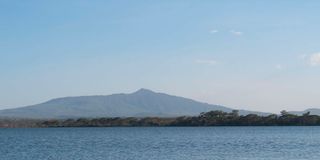How water security shapes Africa's climate resilience

Lake Naivasha, a freshwater lake. Africa's water situation is a paradox. While the continent holds about nine per cent of the world's freshwater resources, unequal distribution, poor infrastructure, and climate variability leave millions in chronic water stress.
What you need to know:
- Nature-based solutions like restoring wetlands, reforesting watersheds and promoting soil conservation can enhance natural water storage and filtration.
For Africa, the recently marked World Water Day is a reminder to address water security for better climate resilience. Water security is reliable access to sufficient and safe water for health, livelihoods, and ecosystems. It's about managing water wisely to buffer communities against climate shocks like droughts, floods, and unpredictable rainfall in Africa, where climate change amplifies existing water challenges.
Africa's water situation is a paradox. While the continent holds about nine per cent of the world's freshwater resources, unequal distribution, poor infrastructure, and climate variability leave millions in chronic water stress. Recent reports, including the Africa Water Vision 2025 by the African Union, highlight that over 300 million Africans lack access to clean drinking water, and climate change is worsening this gap.
Africa's water crisis disproportionately affects women and girls, who often bear the primary responsibility for water collection, limiting their educational and economic opportunities. The impact extends beyond immediate human needs. Erratic rainfall patterns, prolonged droughts, and the depletion of water resources make it increasingly difficult for farmers to cultivate crops and raise livestock, leading to food insecurity, malnutrition, and increased poverty, particularly in rural communities.
Climate change is exacerbating these challenges. Africa's major lakes, crucial freshwater resources, are warming alarmingly, with minimum temperatures rising faster than maximum temperatures. This warming trend affects water quality, ecosystem health, and the livelihoods of millions who depend on these water bodies. The situation is further complicated by non-climatic stressors and the continent's high susceptibility to climate change due to its warm climate.
In Kenya, the National Water Master Plan 2030 reveals that nearly 40 per cent of the population still relies on unsafe water sources. These statistics reflect a daily struggle for families, farmers, and pastoralists whose lives hinge on water availability.
Climate resilience depends heavily on water security. The recent prolonged drought in the Horn of Africa, the worst in four decades, is a perfect example. Reduced rainfall, linked to climate change, triggered failed harvests, livestock deaths, and food insecurity for over 20 million people. Without reliable water sources, communities could not irrigate crops, sustain livestock, or maintain basic hygiene, pushing them into cycles of poverty and displacement. Conversely, when floods hit, excess water becomes destructive, washing away infrastructure and contaminating supplies. Rising temperatures increase evaporation rates, drying up rivers and soils. They also intensify rainfall in some regions, causing flash floods.
Meanwhile, population growth and urbanisation strain existing supplies. Africa's urban areas face daily water rationing, while rural communities walk for hours to fetch water. This scarcity fuels conflicts due to competition over dwindling resources, escalating tensions between farmers and herders.
Building climate resilience, therefore, starts with securing water. This requires a mix of infrastructure investment, nature-based solutions, and governance reforms. The Africa Water Vision 2025 emphasises transboundary cooperation, noting that 60 per cent of Africa's freshwater crosses borders. Shared management of rivers like the Nile and Niger can prevent disputes and ensure equitable access.
Kenya's Water Master Plan prioritises dams, boreholes, and piped systems to expand storage and distribution. However, infrastructure alone isn't enough. Nature-based solutions like restoring wetlands, reforesting watersheds and promoting soil conservation can enhance natural water storage and filtration. Community-led reforestation projects reduce flooding and improve groundwater recharge, showing how ecosystems can be allies in climate adaptation.
Equally important is adapting agricultural practices. Over 95 per cent of Africa's agriculture is rainfed, making it susceptible to dry spells. Techniques like drip irrigation, rainwater harvesting and drought-resistant crops can reduce water waste and stabilise yields. Smallholder farmers using sand dams can transform barren lands into productive farms in arid areas. These and other localised solutions, coupled with policy and funding, can build resilience from the ground up.
Governance is pivotal in strengthening institutions to manage water resources transparently and inclusively. Kenya's recent establishment of water resource user associations empowers communities to govern local sources collaboratively. Similarly, Rwanda's national water policy integrates climate adaptation into every planning sector, from energy to health. Such frameworks make water security a cornerstone of development.
However, significant challenges remain. Limited infrastructure, high costs of treatment plants, lack of funding for water projects, poor maintenance of existing facilities, and inadequate policies and regulations hinder progress. Many African countries struggle with outdated or nonexistent water supply systems, making it difficult to provide clean water to communities, especially in rural areas. The high cost of treating wastewater and insufficient funding for water projects further complicate efforts to improve water security.

